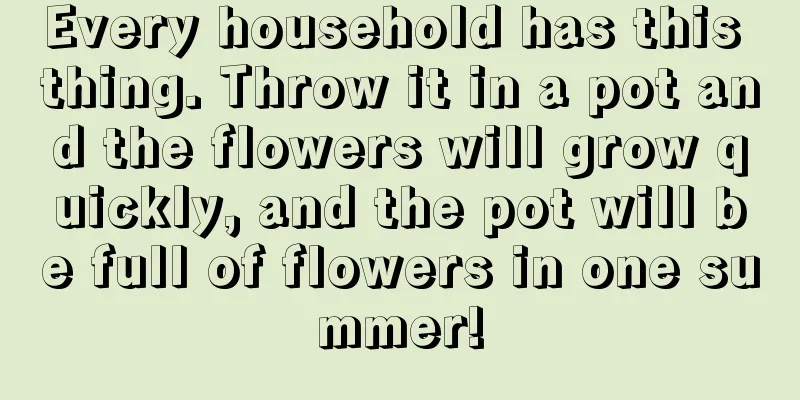Every household has this thing. Throw it in a pot and the flowers will grow quickly, and the pot will be full of flowers in one summer!

Glass beadsWhen I was a kid, I played checkers. There were a lot of glass beads in them. Later, the colors of glass beads were not complete. You can use them to pad the bottom of the basin. It is more useful than any stones. More importantly, it is clean and hygienic. You don't need too many glass beads to pad the bottom of the pot, just one layer is enough. You can take them out and reuse them when you change the pot for the second time. It can be said to be very convenient. Lychee ShellIt’s the season for eating lychees. Don’t throw away the lychee shells after eating them. They are perfect for lining the bottom of a bowl. It is best to rinse the lychee shells to remove the sugar to avoid attracting insects, then dry them in the sun. Putting them in a flower pot is not only breathable and prevents root rot, but can also be used as fertilizer. Edamame skinSummer is the season for eating edamame. The skin of edamame is hard. People who have peeled edamame know that it can be used to pad the bottom of the basin. The edamame skin can be rinsed and dried before use. The boiled edamame skin can be dried and used as a base if it has no taste, but it is best not to use salty ones. Corn CoatingThe thick coating of corn is also a natural breathable material. Don’t throw it away when you eat corn. Dry the corn husks, tear them into small pieces, and place them at the bottom of the pot. They are breathable and clean, and are also an absolute natural fertilizer. Grilling charcoalThe charcoal used for barbecue, some scraps do not need to be thrown away, use it to pad the bottom of the basin to sterilize and prevent insects, and it is breathable You can also put some charcoal chips under the succulent plants to prevent them from black rot and waterlogging in the hot summer. Then you don't have to worry about watering them. Plastic foamDon’t throw away the plastic foam used in online shopping packaging as garbage. Use it as a base for your basin Plastic foam is suitable for padding the bottom of orchid pots, because orchids have thick and fragile roots, and plastic is light, insect-proof and rot-proof, making it a very good material for padding pots. Broken tilesThe broken tiles left over from renovation can also be used as a base for the basin, and they have an unexpected cooling effect in summer. Ceramic tiles are generally heat-insulating and heat-resistant. Placing them at the bottom of the pot can help cool the flowers. They are perfect for flowers like roses that "play dead" at high temperatures. Screen windowIn summer, the old screens at home can be cut into pieces to pad the bottom of the pot, which is breathable and prevents root rot. Moreover, it is thin and does not take up space. The screen net is suitable for small potted plants like succulents. The flower pot itself is relatively small, so a layer of screen net is enough, and you don’t have to worry about waterlogging when watering. Broken bonesBoil the large bones left over from the fish you usually eat in clean water to remove the salt, then expose them to the sun for a few days. When they are crispy, you can crush them and use them to pad the bottom of the basin! Bones contain phosphorus and calcium, which can promote the growth of flowers and make your flowers bloom more vigorously! These little things that cushion the bottom of the pelvis in summer Do you have them at home? Collect it now It will be useful next time |
>>: How to propagate bougainvillea
Recommend
Northeast Peanut Planting Time and Method
Northeast Peanut Planting Time When sowing Northe...
How to prune bougainvillea (pruning method diagram)
1. Pruning time Bougainvillea is usually pruned i...
If you grow lisianthus in water like this, it will look beautiful and fairy-like!
How to grow lisianthus in water Branch arrangemen...
What are the advantages and disadvantages of watering flowers with rice water? How to use rice water correctly
Benefits of using rice water to water flowers Ric...
The difference between the Nanyang Jacaranda and the Blue Jacaranda
1. Different plant heights The Nanyang Ying is al...
Flowering period and main value of Potentilla fruticosa
1. Flowering period There are many reasons why pe...
How to cultivate the bell tree
Growing conditions of the bell tree The hanging b...
How many pounds of dandelion can be produced per acre?
Dandelion acre yield Dandelion is a plant that gr...
What are the succulents suitable for growing in winter?
Gyokuro The plant is short and crystal clear, and...
How to water Jade Butterfly
Water resistance of each part First of all, there...
How and when to plant mustard? Which month is best for planting?
Suitable planting time for mustard The planting t...
Bowl lotus picture
Apricot Yellow Lotus The flower buds are long pea...
What to do if the bougainvillea wilts (What to do if the bougainvillea you bought wilts)
Root rot in summer causes wilting In the summer, ...
Does the kapok tree have fruits? How many kinds are there?
1. Does the kapok tree have fruit? There are many...
How to grow crabapple
1. Lighting Most crabapples prefer sunlight. When...









